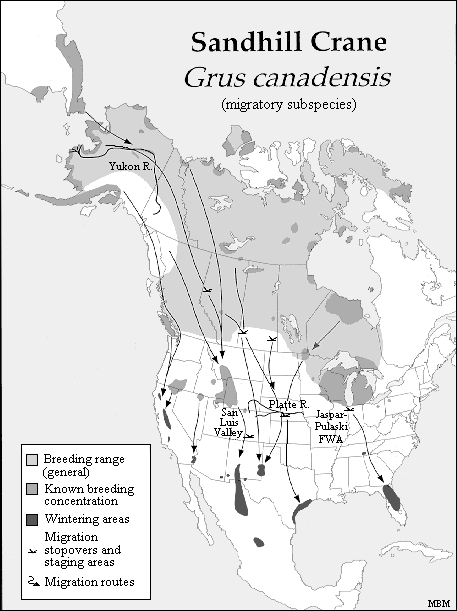Sandhill Crane
This species of large crane is from North America and extreme northeast Siberia. The name of this bird refers to its habitat at the Platte River, on the edge of Nebraska's Sandhills on the American Plains. Adults are gray overall; during breeding, their plumage is usually much worn and stained, particularly in the migratory populations, and looks nearly ochre. The average weight of the larger males is 4.57 kg, while the average weight of females is 4.02 kg, with a range of 2.7 to 6.7 kg across the subspecies. Sandhill cranes have red foreheads, white cheeks, and long, dark, pointed bills. In flight, their long, dark legs trail behind, and their long necks keep straight. Immature birds have reddish-brown upperparts and gray underparts. The sexes look alike. The average height of these birds is around 80 to 136cm. There are six subspecies of Sandhill cranes—greater, lesser, Florida, Cuban, Mississippi and Canadian. However, there is some debate on the Canadian Sandhill crane being a distinct subspecies, as it overlaps with lessers in some areas and greaters in other areas.
Habitat
Sandhill Cranes are large birds that live in open habitats, so they’re fairly easy to spot if you go to the right places. In summer look for them in small bogs, marshes, and prairies across northern North America and the southeastern United States. In winter they form immense flocks in places like Bosque del Apache, New Mexico, and Anahuac National Wildlife Refuge, Texas. Their bugling calls are unique and can be heard from miles away—they can help alert you to this species’ presence, particularly as they pass overhead on migration. Their normal habitats include prairies, fields, marshes, tundra. Habitat varies with region, but usually nests around marshes or bogs, either in open grassland or surrounded by forest. Northernmost birds nest on marshy tundra. In migration and winter, often around open prairie, agricultural fields, river valleys.


Diet
They are omnivorous. Their Diet varies widely with location and season. Major food items include insects, roots of aquatic plants; they also eat rodents, snails, frogs, lizards, snakes, nestling birds, berries, seeds. May eat large quantities of cultivated grains when available.
Breeding
Sandhill cranes are monogamous (one male mates with one female). Once breeding pairs form, they remain together for many years. This species uses many fancy courtship displays to attract a mate and to maintain a bond with their mate. Sandhill cranes trying to attract a mate "dance" for the potential mate. "Dancing" includes five displays, called the Upright wing stretch, Horizontal head pump, Bow, Vertical leap and Vertical toss. Once pairs have formed, they call together and perform dances together to maintain their pair bond. Sandhill cranes raise one brood of chicks per year. In non-migratory populations, they lay eggs anytime between December and August. In migratory populations, sandhill cranes usually lay their eggs in April and May. The male and female work together to build the nest. Nests are made of plant material, and are usually in marshes, bogs, or swales. When the nest is finished, the female lays 1 to 3 eggs. The eggs are oval-shaped and brown with reddish spots. Both parents incubate the eggs. Incubation lasts for 29 to 32 days. When the chicks hatch, they are covered in soft down. They can walk and even leave the nest the same day they hatch. The parents brood the chicks to protect them and keep them warm for up to 3 weeks. They also feed the young. The chicks stay with their parents until they are 9 or 10 months old. When they leave their parents, the young cranes form flocks. They stay in these flocks until they find a mate and begin breeding between the ages of 2 and 7 years old. Juvenile Cranes are called Colts.
Population
Sandhill Cranes are the most abundant of the world’s cranes, with a total population of around 650,000. Lesser Sandhill cranes—our birds—are also the most numerous, with a population of approximately 450-500,000. Around 35,000 lesser Sandhill cranes follow the Pacific Flyway, coming through eastern Washington during their spring and fall migrations, stopping over on the Columbia National Wildlife Refuge and the Hanford Reach National Monument.
Threats
Conversion of grasslands to agriculture, afforestation and other development, habitat loss and conflicts with agriculture.
Conservation
Conduct applied research on issues important to the future of Sandhill Cranes, and develop creative solutions to emerging conservation challenges. We are:
-
Promoting the use of deterrents for those farmers who have experienced crop damage from cranes.
-
Assessing the impacts of hunting on Sandhill Cranes and the illegal shooting of Whooping Cranes and sharing that information with stakeholders and decision-makers.
-
Monitoring impacts of power line and wind turbine development and collaborating with the industry to develop and implement strategies that reduce risks to cranes.
-
Investigating how habitat changes affect crane reproductive success potential.